Question
Discuss the process, including potential risks and benefits, of using bacteria to genetically modify plant crop species. [7]
▶️Answer/Explanation
Ans
Process:
a genetic modification by gene transfer between species;
b gene/Bt gene/DNA segment transferred from bacterium to plant/crop;
c gene/DNA codes for/responsible for desired protein/gene product;
d bacteria have/produce plasmids / gene/DNA inserted into plasmid;
e using restriction enzymes/endonucleases to cut DNA;
f using DNA ligase to join DNA;
g bacterium transfers (modified) plasmid to plant cell;
Benefits:
h increase crop yields / more food produced / less land needed to grow food;
i increase pest/disease resistance / use less pesticides/insecticides/fungicides;
j improves crops to be more nutritious/increased vitamin content;
k increased tolerance to saline soils/drought/high temperatures/low temperatures;
Risks:
l GM organisms could spread to sites (where they will cause harm);
m transferred gene could spread to other species / spread of herbicide resistance to weeds;
n GM crops that produce pesticide could kill non-pest insects/monarch butterflies / insect pests could develop resistance to pesticides/insecticides/Bt toxin;
Question
The Chinese soft-shelled turtle, Pelodiscus sinensis, lives in salt water marshes. The turtle can live under water and out of water.
These turtles have fully developed lungs and kidneys, however, many microvilli have been discovered in the mouth of P. sinensis. A study was undertaken to test the hypothesis that oxygen uptake and urea excretion can simultaneously occur in the mouth.
Initial experiments involved collecting nitrogen excretion data from P. sinensis. The turtle urinates both in water and out of water. When in water it allows waste products to be washed out of its mouth. When out of water it regularly dips its head into shallow water to wash its mouth. The table shows the mean rates of ammonia and urea excretion from the mouth and kidney over six days.

It was noted that during long periods out of water, turtles rhythmically moved their mouths to take in water from a shallow source and then discharge it. Changes in the dissolved oxygen and the quantity of accumulated urea in the rinse water discharged by the turtles were monitored over time as shown in this graph.
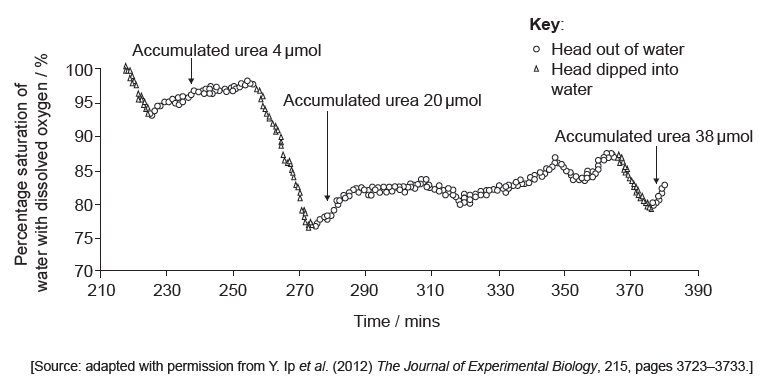
In order to test whether a urea transporter was present in the mouth tissues of the turtles, phloretin (a known inhibitor of membrane proteins that transport urea) was added to the water in which a further set of turtles submerged their heads. The results of that treatment are shown.
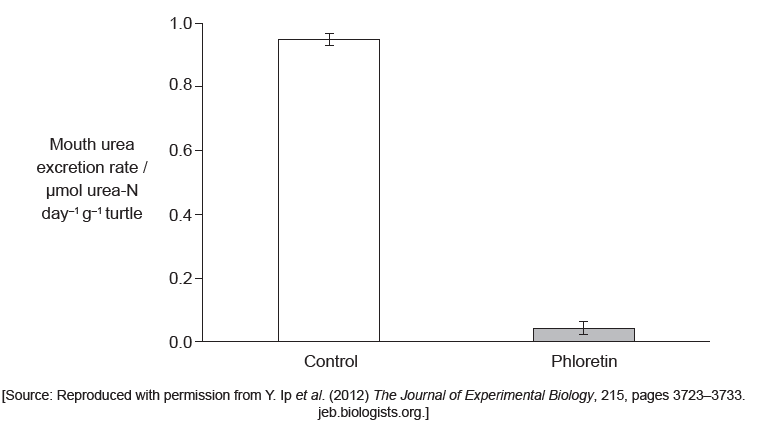
Further research was conducted to determine where mRNA expression of a urea transporter gene might be occurring in P. sinensis. Gel electrophoresis was used to analyse different tissue samples for mRNA activity.

Expression of the urea transporter gene by cells in the turtle’s mouth was assessed by measuring mRNA activity. Turtles were kept out of water for 24 hours and then injected with either a salt solution that matched the salt concentration of the turtle, dissolved ammonia or urea, followed by another 24 hours out of water.
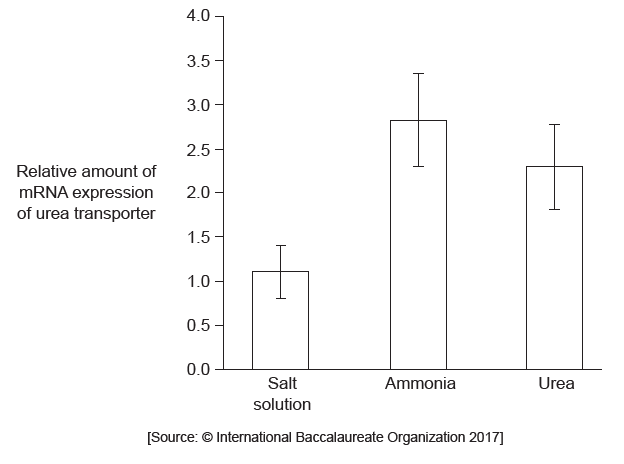
Deduce whether the excretion of ammonia or urea changes more when a turtle emerges from water.
Compare and contrast the changes in urea excretion in the mouth with the changes in urea excretion in the kidney when a turtle emerges from the water.
Describe the trends shown by the graph for dissolved oxygen in water discharged from the mouth.
Suggest reasons for these trends in dissolved oxygen.
Deduce with a reason whether a urea transporter is present in the mouth of P. sinensis.
Outline the additional evidence provided by the gel electrophoresis results shown above.
Identify which of these turtle groups represent the control, giving a reason for your answer.
Suggest a reason for the greater expression of the gene for the urea transporter after an injection with dissolved ammonia than an injection of urea.
The salt marshes where these turtles live periodically dry up to small pools. Discuss the problems that this will cause for nitrogen excretion in the turtles and how their behaviour might overcome the problems.
▶️Answer/Explanation
Markscheme
a. urea
b. for both mouth and kidney
c. percentage change/change in μmol day−1 g−1 greater with urea/other acceptable numerical comparison
a. both higher/increased on emergence from/with turtle out of water
b. both increased by 0.66 «μmol−1 g−1 when turtle emerges from water»
c. % increase is higher in kidney / kidney 940% versus mouth 73/75% / increase is higher proportionately higher in kidney / kidney x10 versus mouth nearly double/x1.73
d. urea excretion by mouth greater than kidney out of water «despite larger % increase in kidney excretion»
decrease «when head is submerged» and increase when head is out of water
a. oxygen absorbed from water/exchanged for urea when head dipped in water«so oxygen concentration decreases»
b. lungs cannot be used with head in water / can «only» be used with head out of water
c. oxygen from water «in mouth» used in «aerobic cell» respiration
d. oxygen from air dissolves in water when head out of water «so oxygen concentration increases»
a. urea transporter is present
b. less urea «excreted»/ lower rate «of urea excretion» / excretion almost zero when phloretin/inhibitor was present
a. mRNA only in mouth and tongue/in mouth and tongue but not esophagus intestine kidney or bladder
b. bands / lines indicate mRNA for/expression of urea transporter gene
c. urea transporter gene expressed / urea transporters in mouth/tongue / not expressed/made in esophagus/intestine/kidneys/bladder
d. mRNA/transcription/gene expression/urea transporters higher in tongue/more in tongue «than mouth»
salt solution is control because it does not contain a nitrogenous/excretory waste product / it matches the salt concentration of the turtle / the turtle’s body already contains salt / because the turtle lives in salt water/salt marshes / because nothing has been altered
a. ammonia is «highly» toxic/harmful
b. ammonia is more toxic than urea/converse
c. ammonia converted to urea
d. urea concentration raised «by injecting ammonia»
e. difference between ammonia and urea «possibly» not «statistically» significant
Problems:
a. urea becomes more concentrated «in small pools» / lower concentration gradient «between tongue/mouth and water»
b. less water available for urine production/excretion by kidney
OR
less water in ponds for mouth rinsing/more competition for pools (to use for mouth rinsing)
Behaviour to overcome problems:
c. «still able to» dip mouth into/mouth rinse in water/pools
d. «still able to» excrete urea «though the mouth» in the small pools
e. more conversion of ammonia to urea/urea excretion rather than ammonia
f. more urea transporters/expression of urea transporter gene
g. urea excreted «in mouth/via microvilli» by active transport/using ATP
h. excretion with little/no loss of water
Question
Type I diabetes is a leading cause of death in advanced countries and is associated with various severe or fatal complications, including blindness, kidney failure, heart disease, stroke, neuropathy, and amputations. Embryonic stem cells are considered to be a powerful tool in the treatment of diabetes.
In a study, embryonic stem cells were grown in culture and tested for insulin mRNA. A drug was injected into two groups of healthy mice in order to simulate type I diabetes 15 days prior to the transplant of embryonic stem cells. The mice in the transplant group received embryonic stem cells that produce insulin mRNA. The control group did not receive the transplant. The graph shows the blood glucose concentration in both groups.
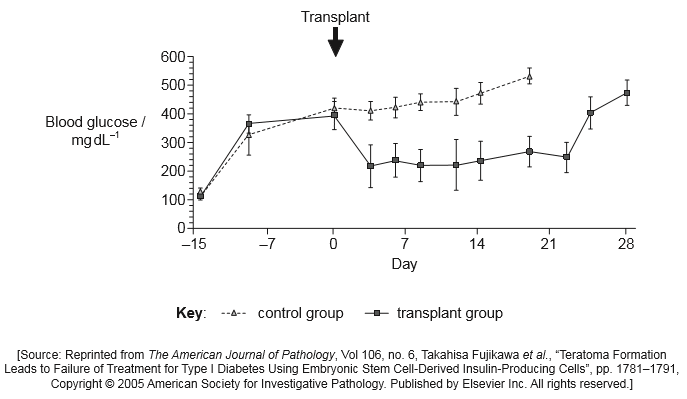
A few years later, a third study used a treatment with umbilical cord stem cells on patients who had suffered from moderate or severe type I diabetes for an average of 8 years. They were divided into two groups: group 1 had moderate diabetes and group 2 had severe diabetes. The patients’ blood was circulated outside the body and exposed to umbilical cord stem cells before returning to the patients’ circulation. The control group had moderate diabetes and received the same treatment but without umbilical cord stem cells.
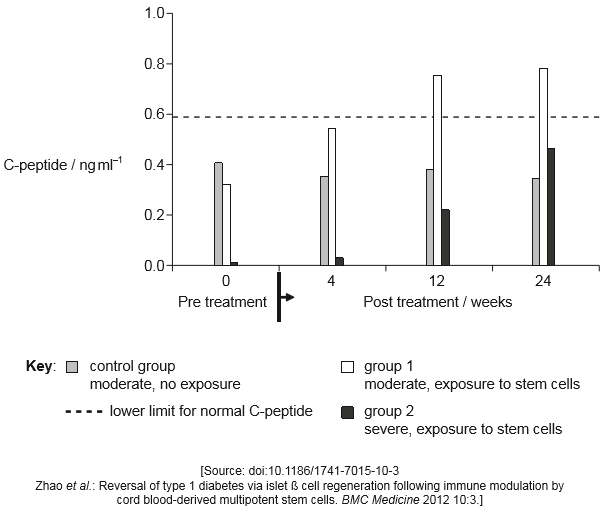
State the highest mean concentration of blood glucose in the mice with transplants.
……………………..mg dL–1
Outline the cause of type I diabetes in humans.
Describe the reason for testing for insulin mRNA in the embryonic stem cell cultures.
Compare and contrast the concentration of blood glucose resulting from the embryonic stem cell transplant with the control.
Evaluate the effectiveness of the embryonic stem cell treatment in controlling blood glucose.
Compare and contrast the results of the treatment on group 1 with the results of the treatment on group 2.
Suggest an ethical advantage of using this type of therapy over embryonic stem cell therapy.
Using the data from all three studies, evaluate the use of embryonic stem cells as a treatment for type I diabetes.
▶️Answer/Explanation
Markscheme
470. Accept answers in the range of 460 to 480 «mg dL–1».
«Autoimmune» destruction of beta/β cells. (Accept B cells instead of β cells).
Reduced/insufficient/no production of insulin
Indicates «stem» cells can produce insulin
OR
is needed for insulin production
OR
shows insulin gene is working/being translated.
Insulin is needed to treat type I diabetes
OR
insulin is needed to bring blood glucose level down
Answers must relate to insulin mRNA.
Decrease in transplant group «after treatment» in contrast to control group which does not decrease/decreases only very slightly «initially»/increases/is higher than treatment group
Glucose «remains» lower in transplant group «than control group» for 2 max 2 weeks/3 weeks/for a time
«in the 4th week» transplant group rises back to level before transplant/to higher level than before transplant/to «near» level of control group
The answer must include some indication of time or non-permanency.
Glucose level still higher than normal/higher than 100 «mg»/higher than it was before the drug injection
Effective/lowers blood glucose for 3 weeks/temporarily/for a short time. This can either be positive (the treatment is effective for a while) or negative (it isn’t effective permanently).
OR
glucose level rises back in 4th week/by day 28
OR
rises back to level of control group
OR
rises again but not above control group
There must be a correct indication of the timing of the effects.
C-peptide increases after treatment in both groups. There must be an explicit comparison.
OR
treatment effective in both groups
OR
both groups rose higher than the control
Similar/same overall/total increase «in both groups»
OR
quoted figures to show this
Smaller percentage/% increase «pre to post treatment» in group 1 «than group 2» Reject answers relating to rates of increase.
OR
quoted figures to show this
Initial increase is greater in group 1
OR
increases slowing/finished/rate of increase reduced by end of study/by week 24 in group 1 but continuing in group 2
Group 1 rose above lower limit «by week 12» and group 2 remained below it «even at week 24»
Umbilical cord «stem» cells are discarded/die if not harvested
OR
harvesting umbilical cord cells does not harm the baby
OR
taking «stem» cells from an embryo may harm/kill it
Do not accept answers relating to consent.
Study 1/study with mice/embryonic stem cell study shows treatment can cause increased insulin production/ reduce blood glucose levels
«Insulin production/reduction in blood glucose in study 1 was» only temporary/did not reduce glucose to normal levels
Study 2 shows increases in C-peptide/insulin
OR
some type I diabetes patients required no insulin after treatment
Study 2 shows treatment effective for a long time/2 years
«Stem cell treatment in study 2» was more successful in some patients than others
OR
more successful for moderate «than more severe» diabetes
Study 3 shows that stem cells can cause C peptide/insulin levels to double/rise significantly/rise above lower limit «for normal C-peptide»/rise and stay raised
«Study 3» does not give evidence for embryonic stem cells
OR
used umbilical cord rather than embryonic stem cells
